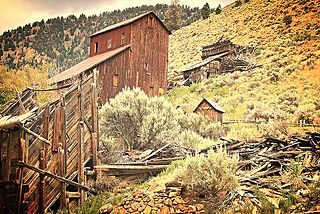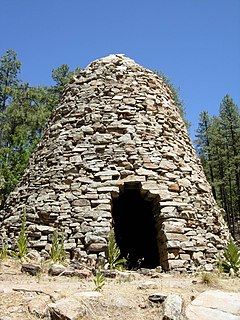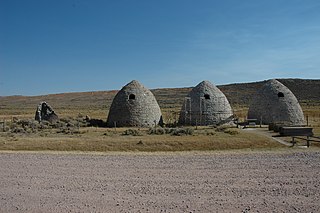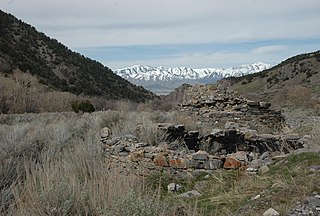
Lemhi County is a county located in the U.S. state of Idaho. As of the 2020 census, the population was 7,974. The largest city and county seat is Salmon. The county was established in 1869, named after Fort Lemhi, a remote Mormon missionary settlement from 1855 to 1858 in Bannock and Shoshone territory.

The Panamint Range is a short rugged fault-block mountain range in the northern Mojave Desert, within Death Valley National Park in Inyo County, eastern California. Dr. Darwin French is credited as applying the term Panamint in 1860 during his search for the fabled Gunsight Lode. The orographic identity has been liberally applied for decades to include other ranges.

Caribou–Targhee National Forest is located in the states of Idaho and Wyoming, with a small section in Utah in the United States. The forest is broken into several separate sections and extends over 2.63 million acres (10,600 km2). To the east the forest borders Yellowstone National Park, Grand Teton National Park and Bridger–Teton National Forest. Most of the forest is a part of the 20-million-acre (81,000 km2) Greater Yellowstone Ecosystem.

Bayhorse is a ghost town in Custer County, Idaho, United States, founded in 1877. After a new gold mine failed, silver was discovered in the area and a mine was started. Bayhorse was originally established by the silver mine.

Ward Charcoal Ovens State Historic Park is an area designated for historic preservation and public recreation located 20 miles (32 km) south of the town of Ely in White Pine County, Nevada. The 700-acre (280 ha) state park protects beehive-shaped charcoal ovens constructed in the latter half of the 19th century.

Onota was a village in the Upper Peninsula of the U.S. state of Michigan. It was located on the Grand Island Bay of Lake Superior near the present-day community of Christmas about five miles (8 km) west of Munising in Alger County. The site of Onota is within the Bay Furnace Campground and Picnic Area of the Hiawatha National Forest. The remains of Bay Furnace, a blast furnace used for smelting iron, is the only extant remnant of the town. Bay Furnace was listed on the National Register of Historic Places and designated a Michigan State Historic Site in 1971.

The Katahdin Iron Works is a Maine state historic site located in the unorganized township of the same name. It is the site of an ironworks which operated from 1845 to 1890. In addition to the kilns of the ironworks, the community was served by a railroad and had a 100-room hotel. The site was listed on the National Register of Historic Places in 1969.

Forest City is a ghost town in Utah County, Utah, United States. It is located in the valley of Dutchman Flat in the upper part of American Fork Canyon, in the Uinta National Forest. A silver mining town just over the mountain from Alta, Forest City was inhabited about 1871–1880. The town grew up around the smelter that was built to process ore from the canyon's mines. The American Fork Railroad, which was intended to serve Forest City and the smelter, stopped short of its destination due to engineering difficulties. Transportation costs rose too high for the mines to continue operating profitably. As the smelter, mines, and railroad closed down, Forest City was abandoned.

The Walker Charcoal Kiln is a structure in the Prescott National Forest near the town of Walker, Arizona and situated in the vicinity of the abandoned Poland Junction Mine near the summit of Renegade Hill. It is listed on the National Register of Historic Places. A sign posted near the kiln reads, "This kiln was constructed around 1880 by Jake and Joe Carmichael to convert oak wood into charcoal for use at nearby smelters. The surrounding forest was cut so heavily for charcoal and mine props in the late 1800s that it is just now becoming productive again." Locally, the kiln is referred to as "the Beehive".
Charcoal Kilns may refer to:

Old Irontown, Old Iron Town, or Irontown, originally Iron City, is an unincorporated community and near-ghost town in Iron County, Utah, United States. It is located in Dixie National Forest, approximately 22 miles (35 km) from Cedar City. The settlement was founded in 1868 as a second attempt to mine iron from Iron Mountain after a disappointing yield from Cedar City. The colony lasted until 1876, when strife from the Edmunds–Tucker Act and the Panic of 1873 forced its closure. The site was added to the National Register of Historic Places in 1971.

The Piedmont Charcoal Kilns in Piedmont, Wyoming, are a remnant of a once-extensive charcoal-making industry in southwestern Wyoming. The kilns were built by Moses Byrne around 1869 near the Piedmont Station along the Union Pacific Railroad. The three surviving beehive-shaped kilns were built of local sandstone about 30 feet (9.1 m) in circumference and about 30 feet (9.1 m) high, with 24-inch-thick (61 cm) walls. A granite marker reads:
Charcoal Kilns were built by Moses Byrne, 1869, to supply the pioneer smelters in the Utah Valley.

The Edward Pulaski Tunnel and Placer Creek Escape Route are two adjacent sites used by the United States Forest Service firefighter Edward Pulaski in the Great Fire of 1910 to save the lives of himself and most of his crew. The sites are located south of Wallace, Idaho in the Idaho Panhandle National Forests. Pulaski's tunnel and escape route are listed on the National Register of Historic Places in 1984.
The Woodstock Iron Works ran from 1848 to 1884 and was located in what is now Upper Woodstock, New Brunswick, Canada. In its prime, the iron ore that came from the works was thought to be some of the highest quality ore. The Iron works was closed in 1884 due to increased competition from the United States.
The Charcoal Kilns near Eureka, Utah were listed on the National Register of Historic Places in 1979. The listing included two charcoal kilns that each are about six feet in diameter and four feet deep, built out of stone. They are believed to have been built or used to support the Wyoming Smelter in 1871.

The Soldier Creek Kilns near Stockton, Utah date from about 1873, the time of their construction, and were in use up until about 1899. Also known as the Waterman Coking Ovens, they were listed on the National Register of Historic Places (NRHP) in 1980. The listing included 14 contributing structures over 30 acres (12 ha).
The Tybo Charcoal Kilns are a pair of charcoal kilns located 4 miles (6.4 km) north of Tybo, Nevada. Both kilns are 30 feet (9.1 m) tall and 25 feet (7.6 m) in diameter and were built from rocks and mud. The kilns each have three openings: a top opening, a door at ground level, and a rear window with a ramp for wood wagons. The kilns were among 15 built in 1874 for the Tybo Consolidated Company. The company, which mined the region's silver, used charcoal to fuel its smelting furnace. To acquire its fuel, it imported wood from nearby hills, which it then converted to charcoal in the kilns.
White Knob, Idaho is a ghost town in Custer County, Idaho. It is situated on Mine Hill between the town of Mackay, Idaho and the White Knob Mountains in the Pioneer Mountains.
Clarksville Iron Furnace was a charcoal iron furnace in Unicoi County, Tennessee, built in 1833 and operated until 1844. Its ruins are in Cherokee National Forest and are listed on the National Register of Historic Places.

The Frisco Charcoal Kilns are remnants of silver mining in the Utah ghost town of Frisco. They remain as a visual documentation of the state's mining history
















